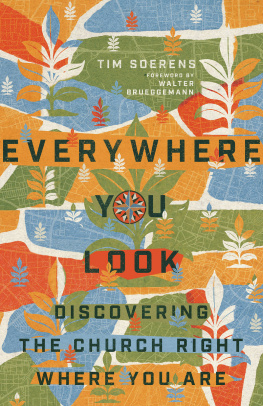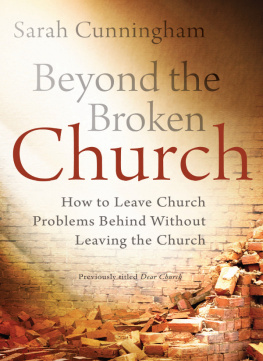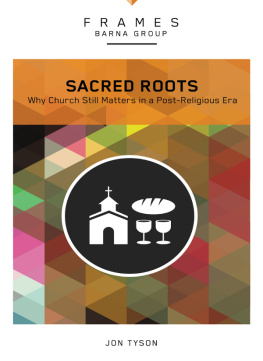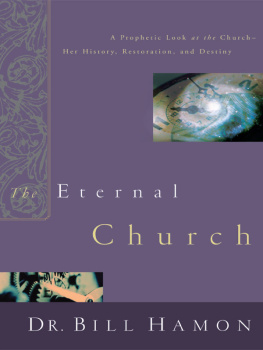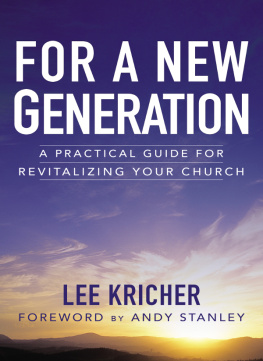Sommaire
Pagination de l'dition papier
Guide
EVERYWHERE
YOU
LOOK
DISCOVERING
THE CHURCH RIGHT
WHERE YOU ARE
TIM SOERENS
FOREWORD BY
WALTER BRUEGGEMANN
InterVarsity Press
P.O. Box 1400, Downers Grove, IL 60515-1426
ivpress.com
2020 by Timothy Soerens
All rights reserved. No part of this book may be reproduced in any form without written permission from InterVarsity Press.
InterVarsity Press is the book-publishing division of InterVarsity Christian Fellowship/USA, a movement of students and faculty active on campus at hundreds of universities, colleges, and schools of nursing in the United States of America, and a member movement of the International Fellowship of Evangelical Students. For information about local and regional activities, visit intervarsity.org.
Scripture quotations, unless otherwise noted, are from the New Revised Standard Version of the Bible, copyright 1989 by the Division of Christian Education of the National Council of the Churches of Christ in the USA. Used by permission. All rights reserved.
While any stories in this book are true, some names and identifying information may have been changed to protect the privacy of individuals.
Published in association with the literary agency of D.C. Jacobson & Associates, an Author Management Company. http://www.dcjacobson.com.
by Cot Soerens.
Cover design and image composite: David Fassett
Interior design: Daniel van Loon
Images: abstract color shapes CSA Images / Getty Images
star illustration CSA Images / Getty Images
leafy plant illustration CSA Images / Getty Images
ISBN 978-0-8308-4196-7 (digital)
ISBN 978-0-8308-4156-1 (print)
This digital document has been produced by Nord Compo.
For Lukas and Joaqun, with all my love
FOREWORD
Walter Brueggemann
T im Soerens has written a passionate book concerning the future of the church. To his writing he brings his years of street smarts about how communities work. His book is both deeply grounded in vigorous theological claims and wisely alert in practical matters. He begins his account of the church with a stark either-or: either institutional decay or vibrant movement. It does not take long for him to dispose of the status quo as a viable option. While the institutional church is needed, its heavy burden of nostalgia, default to quick fixes, and shrinking budgets will necessarily require new imagination. Any church is headed for meltdown that has become an end in itself, preoccupied with survival and therefore growth.
It is, however, the other side of that either-or that concerns Soerens and that will be the hope-filled future of the church, namely, to recover its authentic character as a movement of Gods Spirit toward an alternative life in the world. In his transition from theology to practice, Soerens begins by asking the big why question: Why a church at all? The answer is that the churchs why is found in Gods desire to which we may attach our own desire. That desire of God is that the world be a venue of generous neighborliness. The church exists to embrace the desire of God!
That embrace of Gods desire, however, is not simply a task to be performed by our best effort and commitment. Much beyond our best effort and commitment, we are invited to notice what Gods own Spirit is doing in the world, nothing less than deconstructing and obstructing our contemporary towers of pride, greed, and control. Soerens sees quite clearly that Gods Spirit is actively and assertively countercultural. In a world of fear, greed, and hostility, the Spirit is working otherwise to make room for peaceable generosity that runs beyond our own capacity.
The truth of the big why and the countercultural work of the Spirit provides the foundation for communities of faith that sign on for the why and the work that counter the fear and greed of the world. By appeal to the verdict that the neighborhood is the unit of change, Soerens morphs to the parish is the unit of change. Of course, by parish he does not refer to the failed local congregations that remain stuck in rote performances that endlessly reiterate and refuse newness. He refers, rather, to the new parish that is both large enough to live life together and small enough to be known in honest engagement. While he does not acknowledge it, he would surely recognize that many old parishes are already bent toward the new parish and include energized folk who are living together in loving and joyous missional engagement. Thus the new parish model may take heart because there are already many venues of fresh articulation and fresh courage for a way ahead. It might be recognized that Soerens, given his ecclesial background, continues to have one eye on mega-congregations that are much too often focused on growth, power, and wealth. But of course Soerens knows as well many other congregations that live much closer to the why of God.
The remainder of Soerenss fine work is a reflection on the life of the right-sized parish that takes the form of a team that is deeply committed not only to the mission but whose members are deeply committed to each other for a common life of trust, joy, and honesty. His sketch of such a new parish is reminiscent of the early church in the book of Acts in which the members had all things in common. Soerens does not focus on shared economics, but a fully shared life will, perforce, have economic implications. He articulates a suggestive taxonomy of a team of engaged people who live at the center of a parish. Though all the members of the parish are not fully on board with the team, they may and will be drawn toward the vision of such an intentional group. That performed vision, powered by the Spirit, will, he suggests, not only reach the larger church but the civic community as well.
Everyone knows it is a hard time for the church in our culture, a hard time reflected for Soerens in secular Seattle as his home base. Much of that hard time, of course, results from the church having forgotten its character and purpose. In the face of that hard time, Soerens has written a book that teems with hope and possibility for the future, a hope that the church need not reiterate our mistaken past, and a possibility that real people in real time and real circumstance can live out the why of God. The prospect Soerens explores is of a community of glad neighborliness in which faithful folk genuinely delight in one another and happily share a vision of a world that is engaged by the Spirit. Soerens finishes with a judgment that the most elemental need for the church is passionate prayer whereby we put ourselves in the rightful posture that we cannot control the outcomes we seek. I finished reading the book with exhilaration for what lies ahead for the church. Now is no time for regret or anxiety. Now is a time for recovery of the newness of what is old and best in our tradition. Soerens brings his great lived wisdom to his exposition, a practical wisdom whereby we may be instructed. In the new parish there will be no business as usual, but a glad return to the grit and energy of the apostles.
CHAPTER ONE
THE MOVEMENT OR
THE MELTDOWN

